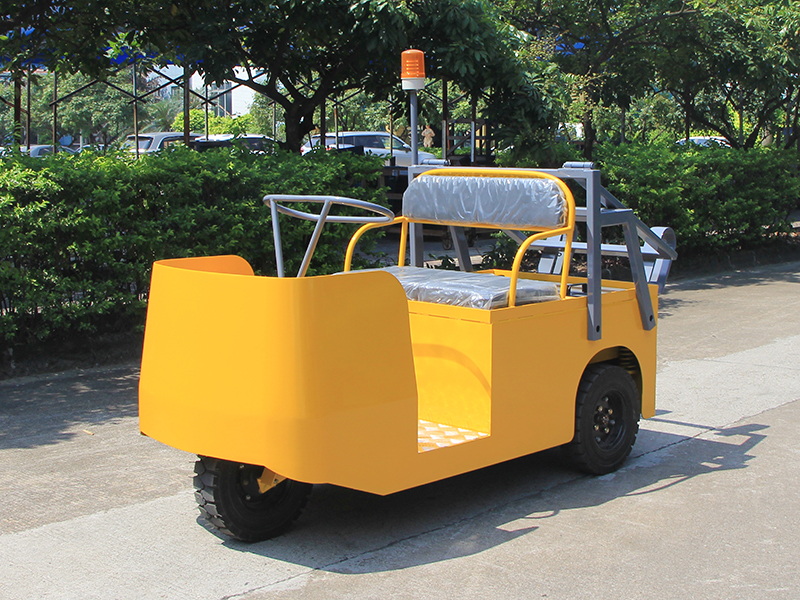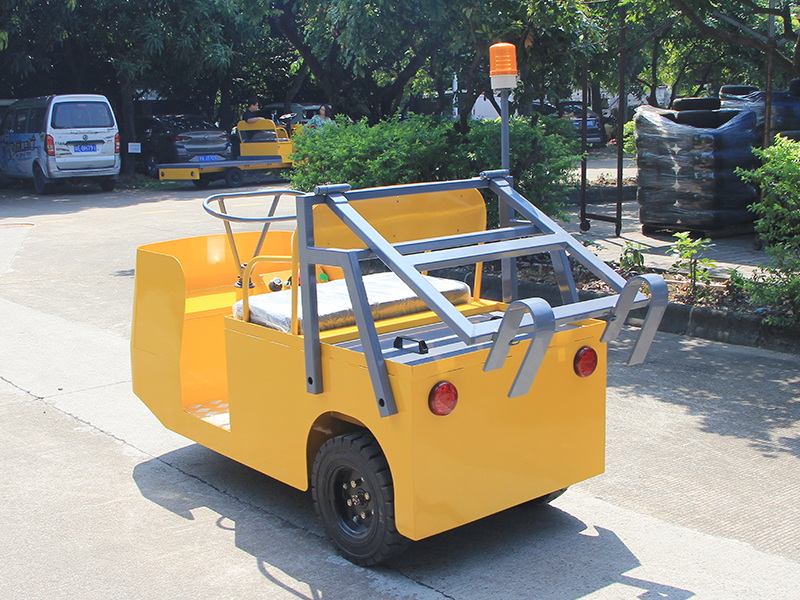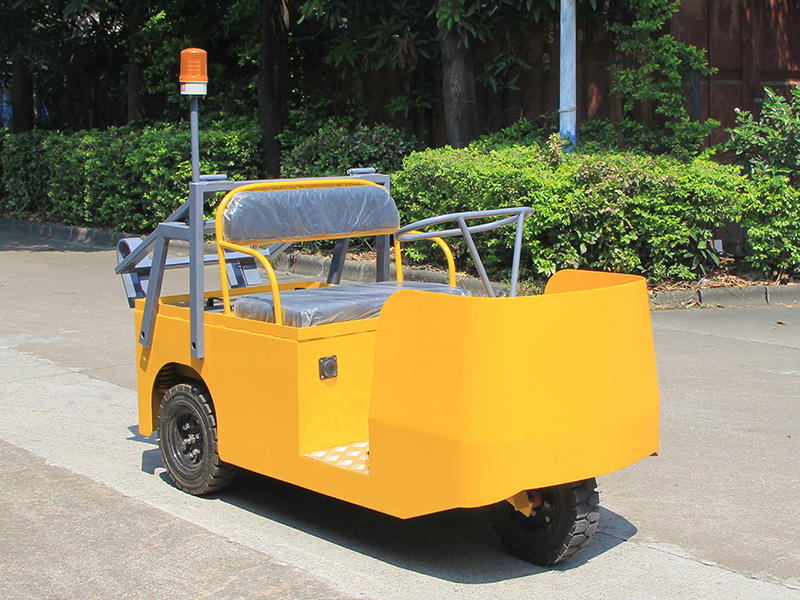Content Menu
● Introduction
● What Are Electric Towing Tractors?
● Manual Towing Solutions: An Overview
● Key Differences: Electric Towing Tractors vs. Manual Towing
● Performance and Efficiency
>> Load Capacity
>> Speed and Productivity
>> Distance and Endurance
● Safety and Ergonomics
>> Operator Safety
>> Ergonomics
● Flexibility and Scalability
>> Handling Multiple Loads
>> Adaptability to Different Environments
● Environmental and Operational Impact
>> Sustainability
>> Noise and Air Quality
● Advanced Features in Electric Towing Tractors
>> Automation and Smart Technology
>> Power Steering and Suspension
>> Safety Sensors and Connectivity
● Cost Considerations
>> Upfront and Operating Costs
>> Maintenance
● Use Cases and Suitability
>> Warehousing
>> Manufacturing
>> Airports
>> Healthcare and Hospitality
● Real-World Examples
>> Warehouse Operations
>> Airport Baggage Handling
>> Manufacturing Supply Chains
● Future Trends in Material Handling
>> Electrification and Automation
>> Integration with Industry 4.0
>> Customization and Modularity
● Conclusion
● FAQ
>> 1. What is the maximum load capacity of electric towing tractors?
>> 2. Are electric towing tractors safer than manual towing?
>> 3. Can electric towing tractors be automated?
>> 4. How long can electric towing tractors operate on a single charge?
>> 5. When should I choose manual towing over electric towing tractors?
Electric towing tractors are revolutionizing material handling across industries, providing a modern, efficient, and safer alternative to traditional manual towing solutions. As logistics, manufacturing, and warehousing operations grow in scale and complexity, the need for reliable, high-capacity, and ergonomic transport solutions becomes more pressing. In this comprehensive article, we'll explore in depth how electric towing tractors stack up against manual towing solutions, examining their features, efficiency, safety, operational impact, and more. We'll also provide visual comparisons and real-world examples to illustrate their differences.

Introduction
Material handling is the backbone of countless industries, from logistics and warehousing to manufacturing and airport operations. The ability to move goods efficiently, safely, and cost-effectively can make or break operational success. Traditionally, manual towing-using human effort and simple mechanical aids-has been the default approach for moving loads. However, with the advent of electric towing tractors, businesses now have access to powerful tools that can dramatically improve productivity and safety.
This article delves into the key differences between electric towing tractors and manual towing solutions, providing a detailed comparison to help you make informed decisions for your material handling needs.
What Are Electric Towing Tractors?
Electric towing tractors are battery-powered vehicles engineered to tow carts, trailers, or trolleys loaded with goods. They come in a variety of sizes and configurations, from compact pedestrian models for tight warehouse aisles to heavy-duty ride-on machines for industrial sites and airports. Some electric towing tractors are designed for indoor use, while others are robust enough for outdoor environments.
Key features of electric towing tractors include:
- Electric Motor: Provides consistent, powerful towing force.
- Battery Power: Typically lithium-ion or lead-acid batteries, offering several hours of operation per charge.
- Operator Platform: Options for ride-on, stand-on, or walk-behind operation.
- Safety Systems: Brakes, emergency stop buttons, speed controls, and sometimes advanced sensors for collision avoidance.
- Modular Design: Ability to connect multiple carts or trailers for batch movement.
Manual Towing Solutions: An Overview
Manual towing refers to the physical movement of loads using human effort, often aided by simple mechanical devices. Common manual towing tools include:
- Hand Trucks and Dollies: For moving boxes or small loads.
- Pallet Jacks: For transporting palletized goods over short distances.
- Push Carts and Trolleys: For general material movement in stores, hospitals, or small warehouses.
While manual towing is cost-effective and flexible for light-duty applications, it quickly reaches its limits in terms of load capacity, distance, and operator fatigue.
Key Differences: Electric Towing Tractors vs. Manual Towing
| Feature | Electric Towing Tractors | Manual Towing Solutions |
| Power Source | Battery/Electric Motor | Human Force/Basic Mechanics |
| Load Capacity | Up to 25,000 kg or more | Typically under 500 kg |
| Operator Fatigue | Minimal | High |
| Speed | 7–14 km/h loaded/unloaded | Walking speed (2–4 km/h) |
| Safety | Enhanced (brakes, sensors, etc.) | Higher risk of strain/injury |
| Distance Covered | Long distances | Short distances |
| Flexibility | Can tow multiple carts | Limited to single loads |
| Automation | Available (AGV options) | Not available |
| Environmental Impact | Low (electric, no emissions) | None |
| Maintenance | Moderate (battery, electronics) | Low (simple tools) |
Performance and Efficiency
Load Capacity
Electric towing tractors are engineered to handle a wide range of loads, from 1,500 kg for light-duty models up to 25,000 kg or more for heavy-duty industrial tractors. This makes them suitable for moving everything from small parts bins in a warehouse to fully loaded baggage carts at an airport.
Manual towing solutions, by contrast, are limited by human strength and ergonomic guidelines. Most health and safety authorities recommend limiting manual handling to 25–50 kg per person for short distances. Even with mechanical aids like pallet jacks, exceeding 500 kg becomes unsafe and impractical.
Speed and Productivity
Electric towing tractors can travel at speeds of 7–14 km/h, depending on the model and load. This allows for rapid movement of goods over long distances, significantly increasing throughput in large facilities.
Manual towing is constrained by the operator's walking speed, typically 2–4 km/h. Frequent stops, fatigue, and the need for multiple trips further reduce productivity, especially in operations requiring the movement of large volumes or heavy loads.
Distance and Endurance
Electric towing tractors can operate continuously for 6–8 hours (or more with battery swaps or fast charging), making them ideal for multi-shift operations and large facilities where goods must be transported over hundreds of meters or even kilometers.
Manual towing is limited by human endurance. Operators tire quickly when moving heavy or bulky loads, especially over long distances or uneven surfaces. This leads to frequent breaks, slower operations, and increased risk of errors or accidents.

Safety and Ergonomics
Operator Safety
Electric towing tractors are designed with operator safety in mind. Features such as hydraulic or electric brakes, emergency stop buttons, speed limiters, and ergonomic controls minimize the risk of accidents. Many models include safety sensors that detect obstacles and automatically slow or stop the vehicle to prevent collisions.
Manual towing exposes workers to significant safety risks, including:
- Musculoskeletal Disorders (MSDs): Repetitive pulling or pushing, awkward postures, and heavy loads can cause back injuries, strains, and sprains.
- Slips, Trips, and Falls: Especially when moving loads over uneven or slippery surfaces.
- Fatigue-Related Errors: Tired workers are more likely to make mistakes, increasing the risk of accidents.
Ergonomics
Electric towing tractors reduce or eliminate the need for strenuous physical effort. Operators can ride on or walk behind the vehicle, using intuitive controls to steer and manage speed. This not only improves comfort but also reduces the risk of long-term injuries.
Manual towing, even with ergonomic tools, still requires significant physical effort. Over time, this can lead to chronic pain, decreased productivity, and increased absenteeism.
Flexibility and Scalability
Handling Multiple Loads
Electric towing tractors can easily connect to multiple carts or trailers, forming a “tow train” that moves large volumes of goods in a single trip. This is particularly valuable in just-in-time manufacturing, where parts must be delivered to multiple workstations efficiently.
Manual towing is generally limited to a single cart or load at a time. Attempting to move multiple loads simultaneously increases the risk of accidents and is often prohibited by safety regulations.
Adaptability to Different Environments
Electric towing tractors are available in models suited for both indoor and outdoor use. Some feature compact designs for narrow aisles, while others are ruggedized for rough terrain or weather exposure.
Manual towing tools are typically limited to smooth, flat surfaces and short distances. Their effectiveness drops sharply in large, complex, or outdoor environments.
Environmental and Operational Impact
Sustainability
Electric towing tractors produce zero emissions at the point of use, making them ideal for indoor environments and facilities with strict environmental standards. Modern lithium-ion batteries are increasingly energy-efficient and recyclable, further reducing environmental impact.
Manual towing solutions have no direct emissions but may indirectly contribute to increased labor needs and lower overall efficiency, leading to a larger workforce and associated resource consumption.
Noise and Air Quality
Electric towing tractors operate quietly, reducing noise pollution and improving working conditions. This is especially important in environments like hospitals, airports, or retail centers, where noise can disrupt operations or customer experience.
Manual towing is also quiet but becomes impractical for large-scale operations.
Advanced Features in Electric Towing Tractors
Automation and Smart Technology
Some electric towing tractors are equipped with autonomous navigation systems, allowing them to operate as Automated Guided Vehicles (AGVs). These machines can follow pre-set routes, avoid obstacles, and even communicate with warehouse management systems for optimized material flow.
Power Steering and Suspension
Advanced models offer power steering and suspension systems for smoother operation, easier maneuvering, and reduced operator fatigue, even when towing heavy loads.
Safety Sensors and Connectivity
Modern electric towing tractors may include:
- Proximity Sensors: To detect people or objects in the path.
- Load Sensors: To ensure safe operation within rated capacities.
- Telematics: For real-time monitoring, maintenance alerts, and fleet management.
Cost Considerations
Upfront and Operating Costs
Electric towing tractors require a higher initial investment than manual tools. However, the long-term savings in labor, reduced injury rates, and increased productivity often result in a lower total cost of ownership.
Manual towing solutions are inexpensive to purchase but can be costly over time due to higher labor requirements, increased risk of injury, and limited scalability.
Maintenance
Electric towing tractors require regular maintenance of batteries, motors, and electronic systems. However, they have fewer moving parts than internal combustion vehicles, resulting in lower maintenance costs compared to traditional forklifts.
Manual tools require minimal maintenance but have a shorter lifespan when used intensively.
Use Cases and Suitability
Warehousing
Electric towing tractors are ideal for moving pallets, bins, and materials between storage locations, shipping docks, and production lines. Their ability to tow multiple carts at once streamlines operations and reduces congestion.
Manual towing is suitable for small warehouses or occasional movement of light loads.
Manufacturing
In just-in-time manufacturing environments, electric towing tractors deliver parts and materials to assembly lines efficiently, supporting lean production and minimizing downtime.
Manual towing is limited to small-scale or low-volume operations.
Airports
Electric towing tractors are commonly used to move baggage carts, cargo dollies, and other equipment across terminals and runways. Their speed, capacity, and zero emissions make them indispensable in modern airports.
Manual towing is impractical in these environments due to distance and load requirements.
Healthcare and Hospitality
Hospitals and hotels use electric towing tractors to move laundry, food service carts, and supplies quietly and efficiently, improving service and reducing staff fatigue.
Manual towing is reserved for small loads or short distances.
Real-World Examples
Warehouse Operations
> Imagine an electric towing tractor efficiently pulling a train of five carts loaded with goods down a warehouse aisle, with the operator riding comfortably and safely. In contrast, a worker manually pulling a single heavy cart appears fatigued and slow.
Airport Baggage Handling
> Picture an electric towing tractor moving a line of baggage carts from the aircraft to the terminal, reducing turnaround time and minimizing emissions.
Manufacturing Supply Chains
> Visualize a tow train delivering components to multiple workstations on a factory floor, supporting synchronized production and reducing manual handling.
Future Trends in Material Handling
Electrification and Automation
The trend towards electrification and automation in material handling is accelerating, driven by the need for greater efficiency, sustainability, and safety. Electric towing tractors are at the forefront of this movement, with continued advancements in battery technology, autonomous navigation, and smart connectivity.
Integration with Industry 4.0
Electric towing tractors are increasingly integrated with warehouse management systems, IoT devices, and data analytics platforms. This enables real-time tracking, predictive maintenance, and optimized fleet utilization, further enhancing operational performance.
Customization and Modularity
Manufacturers are offering more customizable and modular electric towing tractors, allowing businesses to tailor solutions to specific needs, from compact units for narrow aisles to heavy-duty models for outdoor logistics.
Conclusion
Electric towing tractors represent a significant leap forward in material handling technology. Compared to manual towing solutions, they offer vastly superior load capacity, speed, safety, and operational efficiency. While manual methods may still have a place in small-scale or occasional applications, electric towing tractors are the clear choice for modern, high-volume, and safety-conscious operations. Their ability to reduce labor costs, minimize injuries, support automation, and improve sustainability makes them indispensable in today's competitive industrial landscape.

FAQ
1. What is the maximum load capacity of electric towing tractors?
High-capacity electric towing tractors can handle loads up to 25,000 kg or more, making them suitable for demanding industrial and logistics applications.
2. Are electric towing tractors safer than manual towing?
Yes. Electric towing tractors are designed with advanced safety features such as brakes, emergency stops, ergonomic controls, and sometimes collision sensors, significantly reducing the risk of operator injury compared to manual towing.
3. Can electric towing tractors be automated?
Many modern electric towing tractors can operate autonomously as Automated Guided Vehicles (AGVs), following pre-set routes and integrating with warehouse management systems for fully automated material movement.
4. How long can electric towing tractors operate on a single charge?
Most models offer 6–8 hours of continuous operation per charge, with some featuring quick battery swapping or fast-charging capabilities to support multi-shift operations.
5. When should I choose manual towing over electric towing tractors?
Manual towing is best for light loads, short distances, or environments with minimal material movement. For high-volume, repetitive, or heavy-duty tasks, electric towing tractors are far more efficient, safe, and cost-effective.










































